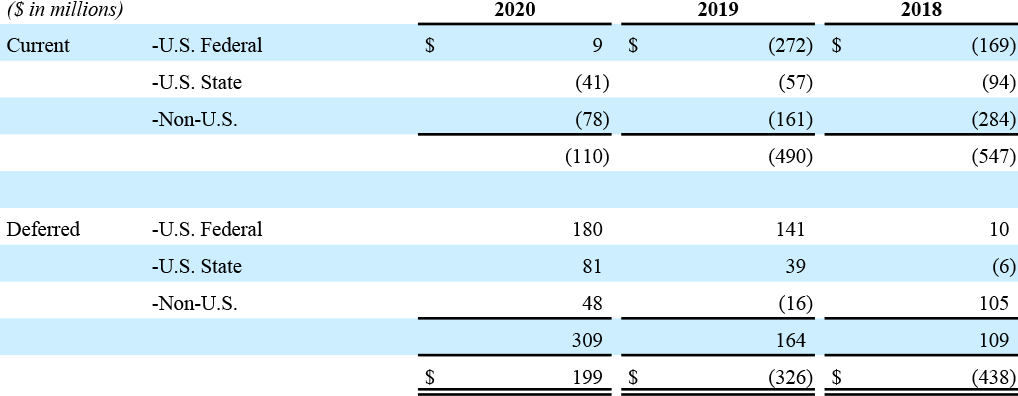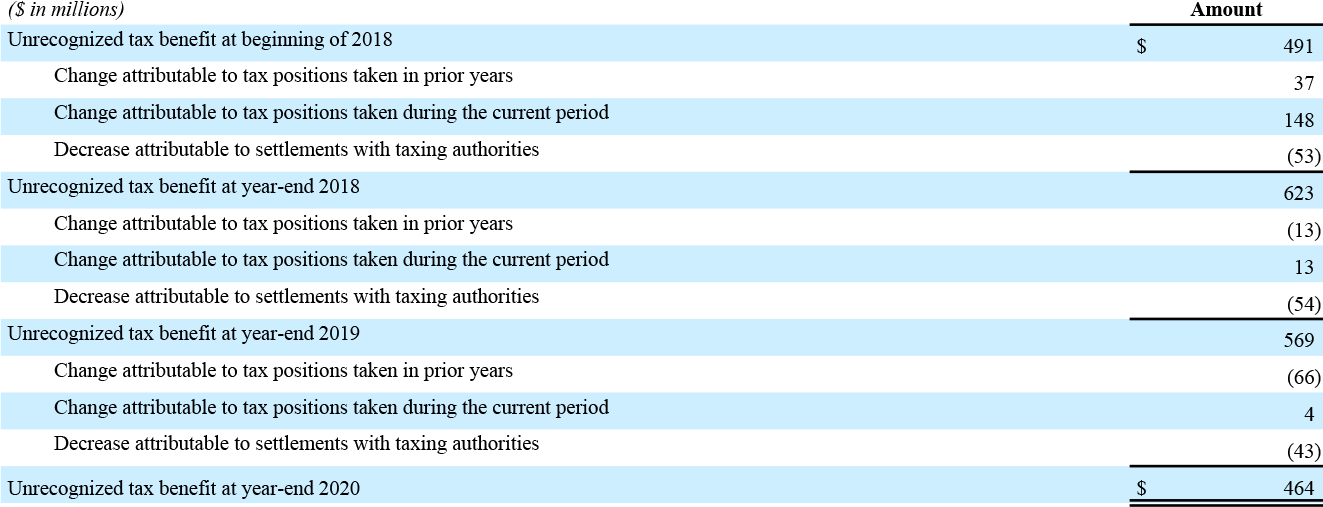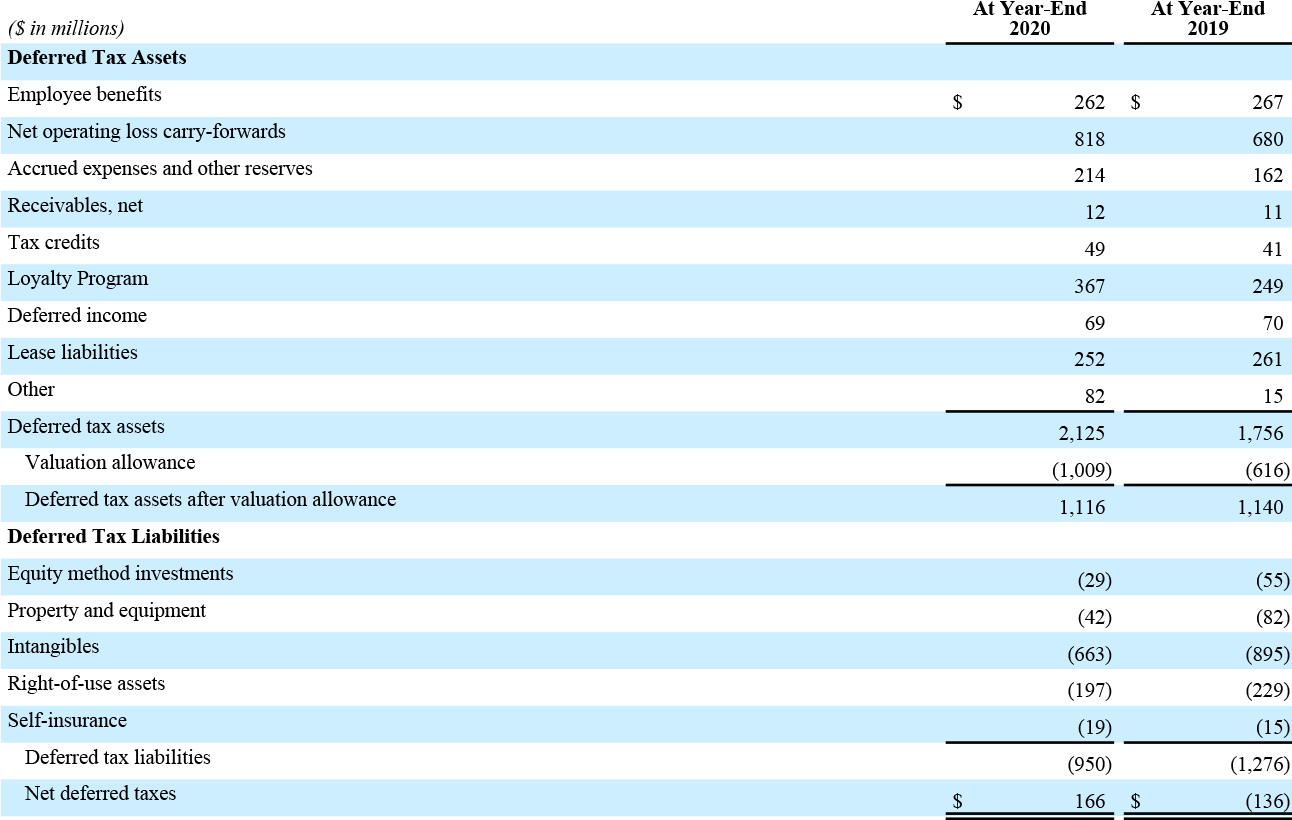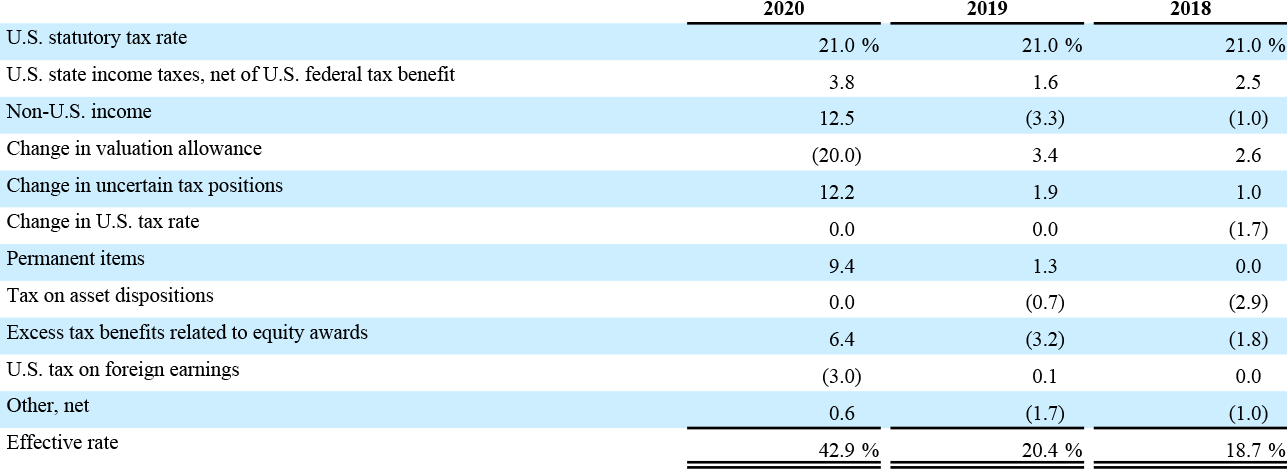Financial Information
Jump to a Section:
PART II
Item 8. Financial Statements and Supplementary Data.
MARRIOTT INTERNATIONAL, INC.
NOTES TO CONSOLIDATED FINANCIAL STATEMENTS
NOTE 7. INCOME TAXES
The components of our (losses) earnings before income taxes for the last three fiscal years consisted of:

Our benefit (provision) for income taxes for the last three fiscal years consisted of:

Unrecognized Tax Benefits
The following table reconciles our unrecognized tax benefit balance for each year from the beginning of 2018 to the end of 2020:

Our unrecognized tax benefit balances included $410 million at year-end 2020, $498 million at year-end 2019, and $497 million at year-end 2018 of tax positions that, if recognized, would impact our effective tax rate. It is reasonably possible that within the next twelve months we will reach resolution of income tax examinations in one or more jurisdictions. The actual amount of any change to our unrecognized tax benefits could vary depending on the timing and nature of the settlement. Therefore, an estimate of the change cannot be provided. We recognize accrued interest and penalties for our unrecognized tax benefits as a component of tax expense. Related interest (benefit) expense totaled $(15) million in 2020, $28 million in 2019, and $3 million in 2018. We accrued interest and penalties related to our unrecognized tax benefits of approximately $85 million at year-end 2020 and $100 million at year-end 2019 on our Balance Sheets.
We file income tax returns, including returns for our subsidiaries, in various jurisdictions around the world. The U.S. Internal Revenue Service (“IRS”) has examined our federal income tax returns, and as of year-end 2020, we have settled all issues for tax years through 2013 for Marriott and through 2012 for Starwood. Our Marriott 2014 and 2015 tax year audits are substantially complete, and our Marriott 2016 through 2018 tax year audits are currently ongoing. Starwood is currently under audit by the IRS for years 2013 through 2016. Various foreign, state, and local income tax returns are also under examination by the applicable taxing authorities.
Deferred Income Taxes
Deferred income tax balances reflect the effects of temporary differences between the carrying amounts of assets and liabilities and their tax bases, as well as from net operating loss and tax credit carry-forwards. We state those balances at the enacted tax rates we expect will be in effect when we pay or recover the taxes. Deferred income tax assets represent amounts available to reduce income taxes we will pay on taxable income in future years. We evaluate our ability to realize these future tax deductions and credits by assessing whether we expect to have sufficient future taxable income from all sources, including reversal of taxable temporary differences, forecasted operating earnings, and available tax planning strategies to utilize these future deductions and credits. We establish a valuation allowance when we no longer consider it more likely than not that a deferred tax asset will be realized.
The following table presents the tax effect of each type of temporary difference and carry-forward that gave rise to significant portions of our deferred tax assets and liabilities as of year-end 2020 and year-end 2019:

Our valuation allowance is attributable to non-U.S. and U.S. state net operating loss carry-forwards. During 2020, our valuation allowance increased primarily due to legislative changes in Switzerland and net operating losses in Luxembourg.
At year-end 2020, we had approximately $31 million of tax credits that will expire through 2030 and $17 million of tax credits that do not expire. We recorded $44 million of net operating loss benefits in 2020 and $10 million in 2019. At year-end 2020, we had approximately $3,938 million of primarily state and foreign net operating losses, of which $2,315 million will expire through 2040.
We made no provision for U.S. income taxes or additional non-U.S. taxes on certain undistributed earnings of non-U.S. subsidiaries. These earnings could become subject to additional taxes if the non-U.S. subsidiaries dividend or loan those earnings to an affiliate or if we sell our interests in the non-U.S. subsidiaries. We cannot practically estimate the amount of additional taxes that might be payable on the undistributed earnings.
Reconciliation of U.S. Federal Statutory Income Tax Rate to Actual Income Tax Rate
The following table reconciles the U.S. statutory tax rate to our effective income tax rate for the last three fiscal years:

The non-U.S. income tax benefit presented in the table above includes tax-exempt income in Hong Kong and Singapore, and a deemed interest deduction in Switzerland, which collectively represented 12.9% in 2020, 8.8% in 2019, and 4.0% in 2018. We included the impact of these items in the non-U.S. income line above because we consider them to be equivalent to a reduction of the statutory tax rates in these jurisdictions. Pre-tax income in Switzerland, Singapore, and Hong Kong totaled $314 million in 2020, $709 million in 2019, and $513 million in 2018.
The non-U.S. income tax benefit also includes U.S. income tax expense on non-U.S. operations, which represents 0.8% in 2020, 2.0% in 2019, and 1.4% in 2018. We included the impact of this tax in the non-U.S. income line above because we consider this tax to be an integral part of the foreign taxes.
Other Information
We paid cash for income taxes, net of refunds, of $279 million in 2020, $526 million in 2019, and $678 million in 2018.